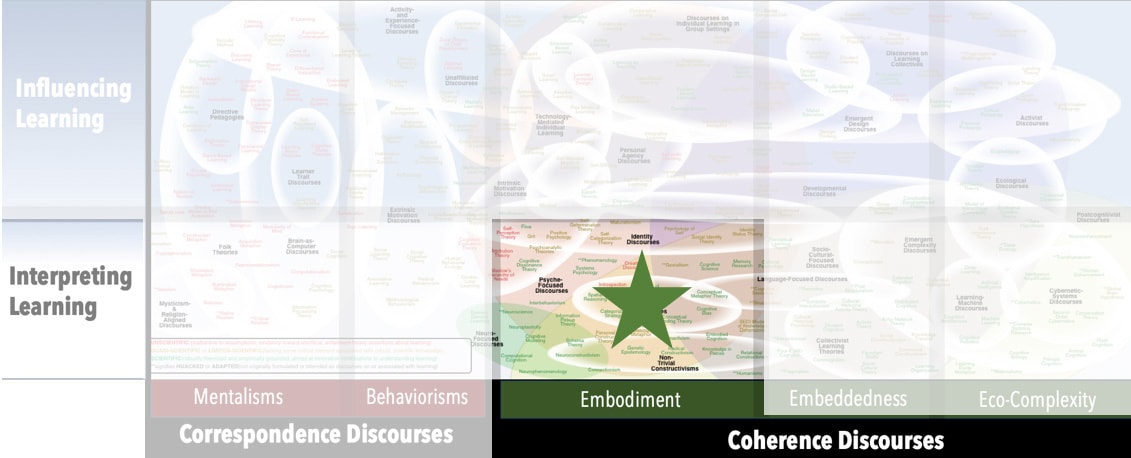AKA
Spatial Intelligence
Spatio-Temporal Reasoning
Focus
Translating bodily motions into abstract, conceptual toolsPrincipal Metaphors
- Knowledge is … scope of possible action and interpretation
- Knowing is … interpreting experience spatially
- Learner is … ambulant being
- Learning is … translating (among motions and conceptions)
- Teaching is … formatting learner motions
Originated
Ancient … but only the mid-20th century as a core aspect of human cognitionSynopsis
Spatial Reasoning encompasses an extensive range of abstract skills that are directly linked to physical actions and/or relations. It is the ability to use body-based actions and positionings as tools or frames to interpret and reason. Most often expressed as lists of skills, Spatial Reasoning includes abilities to imagine transformations (e.g., rotations, reflections, dilations), to estimate dimensions and magnitudes, to make ratio-based comparisons, and to orient in space. Spatial Reasoning is also recognized as a necessary grounding for highly abstract competencies. For example, formal logic relies on images of containment – that is, of imagining items contained in (or not contained in) other items. Associated discourses in include:- Auditory Space Perception – awarenesses of space afforded by the sense of hearing, which (in contrast to sight) can provide more nuanced detail on immersive qualities of one's situation
- Spatial Learning (Covert Reorganization) – the development of those aspects of Spatial Reasoning that have to do with navigating one’s environment, such as knowing where objects are located relative to oneself and to each other. Associated constructs include:
- Object-Location Memory (Spatial Memory) – a component of Spatial Reasoning associated with the remembering of objects, their positions, and their locations
- Spatial Visualization – a component of Spatial Reasoning, typically concerned mainly with the mental manipulation of shapes and figures. Related notions include:
- Covariant Representations – visual displays or interfaces that do not resemble the phenomena that they represent (e.g., a clock represents but does not resemble time)
- Depictive Representations (Pictorial Representations) (Wolfgang Schnotz, 2000s) – physical illustrations or models that foreground critical information about the structure of or relationships within the phenomenon depicted
- Descriptive Representations (Verbal Representations) – spoken or written accounts. While such representations may or may not prompt visual engagement, some prominent theories suggest the effect to be complementary. (See, e.g., Dual Coding Theory, in Learning Styles Theories, or Conjoint Retention, in Memory Research.)
- Graphical Displays (Ioanna Vekiri, 2000s) – images based on predefined conventions that are crafted to support a particular argument and/or to convey a singular, specific meaning/interpretation of a phenomenon
- Spatial Representations (Daniel Schwartz, 2000s) – physical illustrations and/or mental imaginings that are intended to activate one’s embodied knowing (i.e., trigger awarenesses rooted in prior physical experiences)
- Visual Argument – the use of images to sway thinking or to convince.while common in educational materials, Visual Arguments often contain logical fallacies and are frequently used for manipulative purposes (e.g., in advertising)
Commentary
Spatial Reasoning is one of those competencies that is so integral to human cognition that it has been difficult to even notice, let alone characterize and research. Few criticisms have emerged. Those that have arisen tend to be focused on trivialized versions of Spatial Reasoning in which the extensive cluster of abstracted competencies is reduced to isolated, testable skills (e.g., ability to recognize properly rotated shapes on a 2-dimensional page) rather than a complex of integrated competencies.Authors and/or Prominent Influences
DiffuseStatus as a Theory of Learning
It is not entirely appropriate to characterize Spatial Reasoning as a theory of learning. Research into the phenomenon is not yet sufficiently coherent to justify that sort of assertion. However, things seem to be progressing in that general direction, especially when Spatial Reasoning is coupled to Conceptual Metaphor Theory and Conceptual Blending Theory.Status as a Theory of Teaching
Spatial Reasoning is not a theory of teaching.Status as a Scientific Theory
Spatial Reasoning has been an intense focus of interdisciplinary research for some decades now. Even though research is sometimes fragmented and dispersed, there is ample evidence and sufficient coherence to characterize inquiry into Spatial Reasoning as scientific according to our criteria.Subdiscourses:
- Auditory Space Perception
- Covariant Representations
- Depictive Representations (Pictorial Representations)
- Descriptive Representations (Verbal Representations)
- Graphical Displays
- Object-Location Memory (Spatial Memory)
- Spatial Learning (Covert Reorganization)
- Spatial Representations
- Spatial Visualization
- Visual Argument
Map Location

Please cite this article as:
Davis, B., & Francis, K. (2024). “Spatial Reasoning” in Discourses on Learning in Education. https://learningdiscourses.com.
⇦ Back to Map
⇦ Back to List
